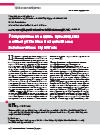Distributed Production Model and New Approaches in National Economic Strategies
DOI: 10.33917/es-5.163.2019.40-46
The article is dedicated to distributing the production process along the elements of global value chains, to the countries’ participation in such chains and the resulting principles of the national growth policy. Special attention is paid to specifics of the Russian situation
References:
|
1. Smorodinskaya N.V. Globalizirovannaya ekonomika: ot ierarkhii k setevomu ukladu [Globalized Economy: from Hierarchies to Network Mode]. Moscow, Institut ekonomiki RAN, 2015. 2. Smorodinskaya N.V. Uslozhnenie organizatsii ekonomicheskikh sistem v usloviyakh nelineinogo razvitiya [Increasing Complexity of the Economic Systems Organization in Conditions of a Non-Linear Development]. Vestnik Instituta ekonomiki RAN, 2017, no 5, pp. 104–115. 3. Smorodinskaya N.V., Katukov D.D. Raspredelennoe proizvodstvo i “umnaya” povestka natsional’nykh ekonomicheskikh strategii [Distributed Production and “Smart” Agenda of National Economic Strategies]. Ekonomicheskaya politika, 2017, no 6, pp. 72–101. 4. Gereffi G., Humphrey J., Kaplinsky R. et al. Introduction: Globalisation, value chains and development. IDS Bulletin, 2001, vol. 32, no 3, pp. 1–8. 5. Cattaneo O., Gereffi G., Staritz C. Global value chains in a postcrisis world: Resilience, consolidation, and shifting end markets. Global value chains in a postcrisis world: A development perspective. Washington, DC, World Bank, 2010, pp. 3–20. 6. OECD. Interconnected economies: Benefiting from global value chains. Paris: OECD Publishing, 2013. 7. SIA, Nathan Associates. Beyond borders: The global semiconductor value chain. Washington, DC, Nathan Associates, 2016. 8. Baldwin R.E. Trade and industrialization after globalization’s second unbundling: How building and joining a supply chain are different and why it matters. Globalization in an age of crisis: Multilateral economic cooperation in the twenty-first century. R.C. Feenstra, A.M. Taylor (eds.). Chicago, IL: University of Chicago Press, 2013, pp. 165–212. 9. Taglioni D., Winkler D. Making global value chains work for development. Washington, DC: World Bank, 2016. 10. Hausmann R., Hwang J., Rodrik D. What you export matters. Journal of Economic Growth, 2007, vol. 12, no 1, pp. 1–25. 11. Hausmann R., Hidalgo C.A., Bustos S. et al. The atlas of economic complexity: Mapping paths to prosperity. Cambridge, MA: MIT Press, 2013. 12. Ivanova I.A., Smorodinskaya N.V., Leydesdorff L. On measuring complexity in a post-industrial economy: The ecosystem’s approach. Quality & Quantity, 2019, vol. 25, no 3, pp. 481. 13. Lanz R., Maurer A. Services and global value chains: Servicification of manufacturing and services networks. Journal of International Commerce, Economics and Policy, 2015, vol. 6, no 3, pp. 1–18. 14. Dedrick J., Kraemer K.L. Intangible assets and value capture in global value chains: The smartphone industry. WIPO Economic Research Working Papers, 2017, no 41. 15. Samper L.F., Giovannucci D., Vieira L.M. The powerful role of intangibles in the coffee value chain. WIPO Economic Research Working Papers, 2017, no 39. 16. NIU VShE. Strukturnye aspekty torgovoi politiki Rossii [NRU Higher School of Economics. Structural Aspects of Russian Trade Policy]. Moscow, ID VShE, 2019 17. Kadochnikov P.A., Knobel’ A.Yu., Sinel’nikov-Murylev S.G. Otkrytost’ rossiiskoi ekonomiki kak istochnik ekonomicheskogo rosta [Openness of the Russian Economy as a Source of Economic Growth]. Voprosy ekonomiki, 2016, no 12, pp. 26–42. |



